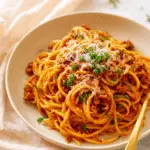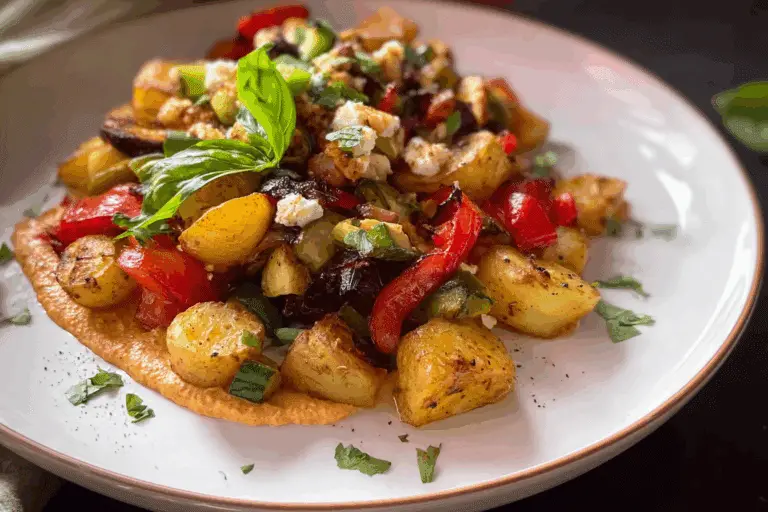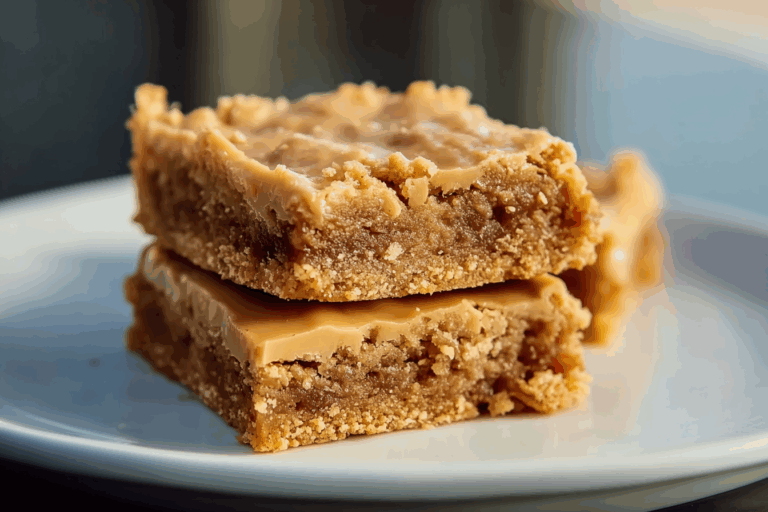Gochujang Bolognese Pasta
When that craving for a warm, soul-hugging pasta dish kicks in, but your taste buds are screaming for something bold and unexpected, this Gochujang Bolognese Pasta steps in like a flavor-packed hero. Creamy, spicy, and comforting, it brings the rich heartiness of a classic Italian bolognese together with the fiery umami punch of Korean gochujang. The result? A fusion dish that’s just as satisfying as your go-to spaghetti night but with a delicious twist that lingers long after the last bite.
Behind the Recipe
I still remember the night I first experimented with this idea. I had leftover ground beef and a half-used jar of gochujang from bibimbap night, staring at me from the fridge. With spaghetti twirling in one hand and a hunch in my gut, I combined the two worlds, added a splash of cream, and boom — something magical happened. Now it’s one of those recipes that keeps popping up in my weeknight dinner rotation, especially when I want comfort without predictability.
Recipe Origin or Trivia
While Gochujang is a staple in Korean kitchens, known for its depth of heat and fermented complexity, Bolognese sauce hails from Bologna, Italy, as a rich, slow-cooked meat sauce typically paired with tagliatelle or fettuccine. What makes this dish special is how the Korean chili paste seamlessly blends into the Italian classic, replacing tomatoes as the sauce’s backbone and creating a dish that feels both fresh and familiar. It’s modern comfort food at its finest.
Why You’ll Love Gochujang Bolognese Pasta
This dish isn’t just bold in flavor. It’s built for busy weeknights and spontaneous dinner guests. Here’s why it’ll quickly become a favorite:
Versatile: Serve it with any pasta shape, add veggies, or swap the protein for your favorite.
Budget-Friendly: Most ingredients are pantry staples or easy to find, and it feeds a crowd with minimal cost.
Quick and Easy: Comes together in under 40 minutes, but tastes like it simmered for hours.
Customizable: Adjust the heat, swap in plant-based meat, or lighten it up with yogurt instead of cream.
Crowd-Pleasing: Everyone from spice-lovers to picky eaters gets hooked after one bite.
Make-Ahead Friendly: Sauce can be made in advance and gets even better overnight.
Great for Leftovers: The flavors deepen with time, making it a killer next-day lunch.
Chef’s Pro Tips for Perfect Results
This fusion dish is full of flavor, but a few simple tips will elevate it to restaurant-level:
- Toast your gochujang in oil briefly before adding liquids. It intensifies the flavor beautifully.
- Use full-fat cream for the silkiest finish, or coconut cream for a dairy-free option that still feels rich.
- Let the sauce simmer gently to develop complexity, even if just for 10–15 minutes.
- Salt the pasta water like the ocean. It’s your only chance to season the pasta itself.
- Finish the pasta in the sauce with a splash of pasta water for that glossy, restaurant-style coating.
Kitchen Tools You’ll Need
You don’t need fancy gear, just these essentials to bring this dish to life:
Large skillet or sauté pan: To cook the sauce and combine everything.
Medium pot: For boiling the pasta.
Wooden spoon or spatula: Ideal for breaking up the meat and stirring the sauce.
Measuring spoons and cups: To keep your ratios just right.
Cheese grater: For topping with fresh parmesan, if using.
Ingredients in Gochujang Bolognese Pasta
Every ingredient plays a role in the symphony of flavors. Here’s what you’ll need:
- Olive oil: 2 tablespoons – For sautéing the aromatics and gochujang.
- Yellow onion: 1 small, finely diced – Adds sweetness and depth to the sauce base.
- Garlic: 4 cloves, minced – Brings bold aroma and punchy flavor.
- Ground beef: 1 pound – Provides the hearty, meaty base of the sauce.
- Gochujang paste: 3 tablespoons – The star, lending spicy, umami-rich character.
- Soy sauce: 1 tablespoon – Enhances saltiness and rounds out the heat.
- Rice vinegar: 2 teaspoons – Adds acidity to balance the richness.
- Brown sugar: 1 tablespoon – Balances spice with a hint of sweetness.
- Heavy cream: 1 cup – Makes the sauce creamy and smooth.
- Pasta (spaghetti or rigatoni): 12 ounces – Holds the bold sauce perfectly.
- Pasta water: ½ cup, reserved – Helps emulsify and bind the sauce.
- Scallions: 2, finely sliced – Adds freshness and color.
- Parmesan cheese (optional): For topping – Offers a nutty, salty finish.
Ingredient Substitutions
Life happens. Here are easy swaps:
Ground beef: Ground chicken, turkey, or plant-based crumbles.
Heavy cream: Coconut cream or Greek yogurt.
Soy sauce: Tamari or coconut aminos for gluten-free.
Brown sugar: Honey or maple syrup.
Spaghetti: Any pasta shape or even rice noodles.
Ingredient Spotlight
Gochujang: This fermented chili paste is the heartbeat of Korean cuisine. Its slow-building heat, touch of sweetness, and savory depth elevate anything it touches.
Heavy Cream: Adds richness and tempers the gochujang’s heat, creating a luscious, balanced sauce.

Instructions for Making Gochujang Bolognese Pasta
This dish feels indulgent, but it’s super simple to make. Here’s how to pull it all together:
- Preheat Your Equipment:
Set a large skillet over medium heat. Fill a pot with water and bring it to a boil for the pasta. - Combine Ingredients:
Heat olive oil in the skillet. Sauté onions until soft, about 5 minutes. Add garlic and cook another minute. Stir in gochujang and let it sizzle for 30 seconds. - Prepare Your Cooking Vessel:
Add ground beef to the skillet. Break it up and cook until browned. Stir in soy sauce, rice vinegar, and brown sugar. Let simmer for 5 minutes. - Assemble the Dish:
Pour in heavy cream, stir well, and reduce heat. Simmer sauce gently for 10 minutes until thickened. - Cook to Perfection:
Boil pasta until al dente. Reserve ½ cup of pasta water before draining. - Finishing Touches:
Add pasta and reserved water to the sauce. Toss everything together over low heat until creamy and fully coated. - Serve and Enjoy:
Plate the pasta hot, topped with scallions and optional parmesan. Serve immediately for the ultimate experience.
Texture & Flavor Secrets
The beauty of this dish lies in the balance. You get tender pasta wrapped in a creamy sauce that clings to every bite. The gochujang brings a smoky, spicy warmth while the cream softens the edges. A sprinkle of scallions adds crunch, and parmesan, if you choose it, delivers that final savory hit.
Cooking Tips & Tricks
Mastering this dish doesn’t take much, but these tricks help:
- Use fresh garlic, not pre-minced, for better flavor.
- Let the sauce simmer gently. Rushing it loses depth.
- Add pasta water gradually to control sauce thickness.
- Don’t rinse your pasta. Starch helps the sauce cling beautifully.
What to Avoid
Here’s how to sidestep common pitfalls:
- Don’t skip the cream. It’s key to balancing the heat.
- Avoid overcooking the pasta. Mushy noodles won’t hold the sauce well.
- Don’t skimp on seasoning. Taste and adjust before serving.
Nutrition Facts
Servings: 4
Calories per serving: 610
Note: These are approximate values.
Preparation Time
Prep Time: 10 minutes
Cook Time: 25 minutes
Total Time: 35 minutes
Make-Ahead and Storage Tips
The sauce can be made a day ahead and refrigerated. Store leftovers in an airtight container for up to 3 days. To freeze, portion sauce separately and thaw overnight before reheating. Add a splash of cream or water to loosen while warming.
How to Serve Gochujang Bolognese Pasta
Serve it hot in shallow bowls with a generous sprinkle of scallions and grated parmesan. Pair it with a crisp cucumber salad or a soft roll for a well-rounded meal. A side of sautéed greens or kimchi also adds a fun twist.
Creative Leftover Transformations
Turn extra pasta into:
- A spicy baked pasta casserole with mozzarella on top.
- Gochujang pasta-stuffed bell peppers.
- A savory pasta omelet with chopped greens and cheese.
Additional Tips
- For a lighter version, use half-and-half instead of cream.
- Want extra protein? Toss in a soft-boiled egg or tofu cubes.
- Add mushrooms or zucchini for more veggie goodness.
Make It a Showstopper
Top with a swirl of cream, a dusting of sesame seeds, and a little drizzle of chili oil. Serve in a shallow, ceramic bowl to show off the sauce. Bright scallions or microgreens pop against the red-orange base for a stunning presentation.
Variations to Try
- Vegan Gochujang Pasta: Use plant-based meat and coconut cream.
- Spicy Seafood Version: Add shrimp or scallops for a Korean-Italian seafood pasta.
- Mushroom Lover’s Twist: Swap beef for mushrooms for earthy richness.
- Cold Pasta Remix: Serve it chilled with extra vinegar and veggies like a spicy pasta salad.
- Cheesy Bolognese: Stir in shredded mozzarella for a gooey finish.
FAQ’s
Q1: Can I make this vegetarian?
A1: Absolutely. Swap the ground beef for lentils, tofu, or mushrooms for a satisfying meat-free version.
Q2: How spicy is gochujang?
A2: It’s medium heat. You can reduce the amount or mix in more cream to mellow it.
Q3: What pasta works best?
A3: Rigatoni, penne, or spaghetti all hold the sauce beautifully.
Q4: Can I use milk instead of cream?
A4: You can, but the sauce won’t be as rich. Use whole milk for better results.
Q5: Is this dish gluten-free?
A5: Use gluten-free pasta and tamari instead of soy sauce to make it gluten-free.
Q6: How long does the sauce last?
A6: Stored properly, the sauce lasts 3 days in the fridge or up to 3 months frozen.
Q7: Can I freeze the pasta?
A7: Freeze the sauce separately for best texture. Cook fresh pasta when ready to serve.
Q8: What does gochujang taste like?
A8: It’s a blend of sweet, spicy, and umami with a slightly fermented tang.
Q9: Can I double the recipe?
A9: Yes, just use a larger skillet and adjust seasoning to taste.
Q10: Do I need to cook gochujang first?
A10: Yes, toasting it briefly in oil deepens its flavor and smooths its texture.
Conclusion
Gochujang Bolognese Pasta isn’t just a fun fusion dish. It’s a crave-worthy comfort food that brings together the best of two bold, delicious cuisines. Trust me, you’re going to love this. Whether it’s your first time cooking with gochujang or you’ve got it on weekly rotation, this one’s a total game-changer. So grab your fork, dig in, and let the flavors take you somewhere exciting.
Print
Gochujang Bolognese Pasta
- Prep Time: 10 minutes
- Cook Time: 25 minutes
- Total Time: 35 minutes
- Yield: 4 servings 1x
- Category: Dinner
- Method: Stovetop
- Cuisine: Fusion
- Diet: Halal
Description
A bold and creamy fusion of Italian bolognese and Korean gochujang, this pasta dish delivers comfort with a spicy, umami-rich twist that’s ready in under 40 minutes.
Ingredients
- 2 tablespoons olive oil
- 1 small yellow onion, finely diced
- 4 cloves garlic, minced
- 1 pound ground beef
- 3 tablespoons gochujang paste
- 1 tablespoon soy sauce
- 2 teaspoons rice vinegar
- 1 tablespoon brown sugar
- 1 cup heavy cream
- 12 ounces spaghetti or rigatoni
- 1/2 cup reserved pasta water
- 2 scallions, finely sliced
- Parmesan cheese (optional), for topping
Instructions
- Set a large skillet over medium heat and bring a pot of water to a boil for the pasta.
- Heat olive oil in the skillet. Sauté onions for 5 minutes until soft, then add garlic and cook for 1 more minute.
- Stir in gochujang and cook for 30 seconds to release its flavor.
- Add ground beef and cook until browned. Stir in soy sauce, rice vinegar, and brown sugar. Simmer for 5 minutes.
- Pour in heavy cream, stir, and reduce heat. Let simmer gently for 10 minutes.
- Boil pasta until al dente. Reserve 1/2 cup pasta water, then drain.
- Combine pasta and reserved water with the sauce. Toss over low heat until well coated.
- Serve hot, topped with scallions and parmesan if using.
Notes
- For a lighter version, use half-and-half or coconut cream.
- Use tamari and gluten-free pasta for a gluten-free version.
- To add veggies, stir in mushrooms or zucchini with the beef.
Nutrition
- Serving Size: 1 bowl
- Calories: 610
- Sugar: 6g
- Sodium: 820mg
- Fat: 36g
- Saturated Fat: 15g
- Unsaturated Fat: 18g
- Trans Fat: 0g
- Carbohydrates: 49g
- Fiber: 3g
- Protein: 27g
- Cholesterol: 95mg
Keywords: gochujang pasta, Korean bolognese, spicy pasta recipe, fusion pasta dish






